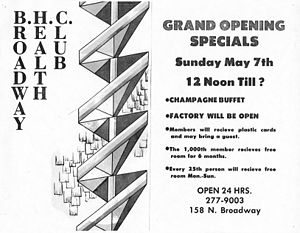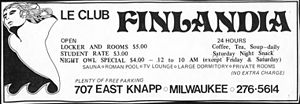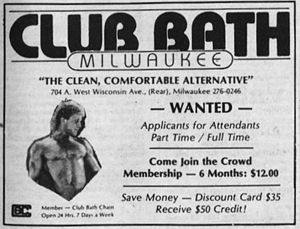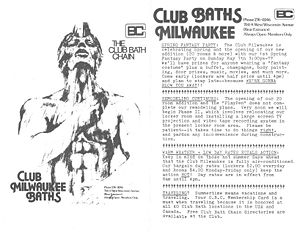Difference between revisions of "WisLGBT Sidebar: Bath houses or Spas"
| (One intermediate revision by the same user not shown) | |||
| Line 4: | Line 4: | ||
''(from an article by Don Schwamb in November and December, 2006 issues of the Q-Life Newspaper)'' | ''(from an article by Don Schwamb in November and December, 2006 issues of the Q-Life Newspaper)'' | ||
| − | [[Image:brdway-health-club-may78.jpg|300px|left| | + | [[Image:brdway-health-club-may78.jpg|300px|left|Ad for Broadway Health Club, 1978]] |
Perhaps even before bars could openly call themselves "gay" or openly cater to the gay community, men's "bath houses" (a.k.a. spas, or "health clubs") have been popular. And even in today's "sex via internet hookup" environment, men's bath houses continue to thrive. Most of America's larger cities have at least one gay bath house- and Milwaukee is no exception. | Perhaps even before bars could openly call themselves "gay" or openly cater to the gay community, men's "bath houses" (a.k.a. spas, or "health clubs") have been popular. And even in today's "sex via internet hookup" environment, men's bath houses continue to thrive. Most of America's larger cities have at least one gay bath house- and Milwaukee is no exception. | ||
Latest revision as of 19:22, 17 March 2010
Wisconsin LGBT History SIDEBAR
Bath houses or Spas in Wisconsin
(from an article by Don Schwamb in November and December, 2006 issues of the Q-Life Newspaper)
Perhaps even before bars could openly call themselves "gay" or openly cater to the gay community, men's "bath houses" (a.k.a. spas, or "health clubs") have been popular. And even in today's "sex via internet hookup" environment, men's bath houses continue to thrive. Most of America's larger cities have at least one gay bath house- and Milwaukee is no exception.
For those who have never been in a gay men’s bath house, this type of establishment is typically a place for consenting men to find nearly-anonymous sex. Upon checking in, a man will be assigned either a locker or private changing room, and will shed all clothes, spending the remainder of his time at the location clad only in a towel. The typical facility will have showers, a steam room and/or sauna, and usually a hot tub, plus a TV lounge, and perhaps an outdoor patio. There will usually also be workout equipment- however infrequently used. Men will “cruise” each other in the various rooms and facilities, and if so inclined “hook up” with one or more other men- usually in a changing room, sometimes (although discouraged) in a common area. The atmosphere is largely one of anonymity. These businesses are popular with both gay men and bisexual men (especially those who are closeted, and/or traveling to the city); it holds great attraction for men into exhibitionism or voyeurism as well.
For some men, this environment lends an air of excitement– but also makes the business a source of some controversy in both the “straight” and LGBT community. The open availability and practice of sexual activities is perhaps easily attacked. But on the other hand, it can be legitimately argued that these types of businesses provide a controlled and private environment for activity that might otherwise take place in a public place: a park, public restroom, alley, or cars. And as some more liberal countries (such as the Netherlands) have found, such controlled outlets for sexual activities (including legalized prostitution) also are proven to reduce the health risk because of their controlled and regulated nature. But for some reason the U.S. continues to be mired in religious fervor more often than reasoned tolerance: whatever happened to the concept of “live and let live” and acceptance of diversity (as long as it doesn’t hurt others) is a mystery.
The first men's bath house documented in Milwaukee is the Finlandia Health Spa (a.k.a. Le Club Finlandia), located at 707 E. Knapp St.. It advertised throughout the publication of the GPU News (1971-1981) as a typical gay bath house, or spa, advertising "Roman pool, private saunas, swedish massage". There was also a gay men’s bath house in Kenosha in the early-mid 1970’s: the Kenosha Steam Baths (on 60th St.) advertised in gay media from the early 1970s until about 1976.
With the rise of gay bars, more health clubs also opened. In 1974 two men’s spas opened in Milwaukee. The Club Bath Milwaukee, a local affiliate of the then-popular national Club Bath chain, opened, in the alley behind 704 W. Wisconsin Ave. (the entrance almost directly facing the Fire Dept. administration building). And in the same year, the Club Health Spa opened at 225 E. St. Paul, possibly owned by the same people as the River Queen (the two businesses advertised together).
In the late 1970s, the Club Milwaukee (Club Baths affiliate), which had opened in 1974, was one of the focal points of the gay men’s community. They held annual “Mr. Club Milwaukee” contests, and held promotional events for the GPU, a gay church parish, and other businesses. Even the legendary Factory Bar got in on the action: in 1978 its owner, Chuck Cicerello opened the Broadway Health Club, upstairs from the Factory at 158 N. Broadway.
But men’s health clubs in Milwaukee had now reached a critical mass, and had attracted the attention of the homophobic police department. In 1979 several violent raids on gay men’s bath houses were launched by the Milwaukee Police Department, led by its homophobic Chief, Harold Breier. These resulted in dozens of arrests, and angry street protests by the gay community. Within 2-3 years nearly all of the gay men’s spas in Milwaukee had closed.
Somehow the Club Milwaukee Baths managed to survive the police harassment- perhaps Milwaukee Club Baths manager Paul DeMarco’s involvement in the founding of the Cream City Business Association (CCBA) in 1981 had a hand in that. But its death knell was the HIV and AIDS health crisis. Almost as soon as the “gay plague” first came to be suspected, both men’s bath houses, and poppers, were near the top of everyone’s list of villains in the crisis-- believed to either cause or contribute to the spread of the disease. It was now the public health authorities who were keeping a close eye on any activities they thought might be sources of contagion. The pressure from health authorities was too much, and in February 1988, the Club Bath Milwaukee succumbed and closed it doors- a trend nationwide as virtually the entire Club Bath chain was closed down, city by city.
Larger cities managed to retain a few bath houses throughout the worst years of the AIDS crisis, almost all locally owned and operated, and some have survived for 20 years or more. In Chicago for example, both Man’s Country and Steamworks have thrived- and these have continued to be meccas for gay men from Wisconsin looking to engage in that type of activity.
After more than a 10 year absence, gay men’s bath houses are seeing a slow resurgence throughout the country, although confined to primarily the largest cities. Milwaukee gained a new spa in 2000 (a local affiliate of an 8-location chain, mostly based in the southwest US), but it has been on tender footing with police and health authorities. It does its best to maintain order, and the BESTD Clinic has cooperated by holding HIV screenings at the local spa about twice a month, and also working with them on any other health scares, helping them show a sense of responsibility for the health of their patrons.
But still, even in the 21st century, there is some police and health authority harassment in the conservative Milwaukee environment. As recently as in the past year, the local spa has been forced to observe ridiculous rules from time to time (such as mandating that changing room doors must be left open when occupied, for example). How long the local spa can remain open remains to be seen- and many Wisconsin gay men still prefer the more populated (and more anonymous) bath houses in more-liberal Chicago.
- Return to PEOPLE page: Wis. LGBT History-- Businesses
- Return to INTRO page: Wisconsin LGBT History Project- Intro
Explore the full web site documenting GLBT life in Milwaukee, Madison, Green Bay, and all of Wisconsin at: http://www.WisconsinGayHistory.org
Source: from an article by Don Schwamb, appearing in the November and December, 2006 issues of the Q-Life Newspaper.



